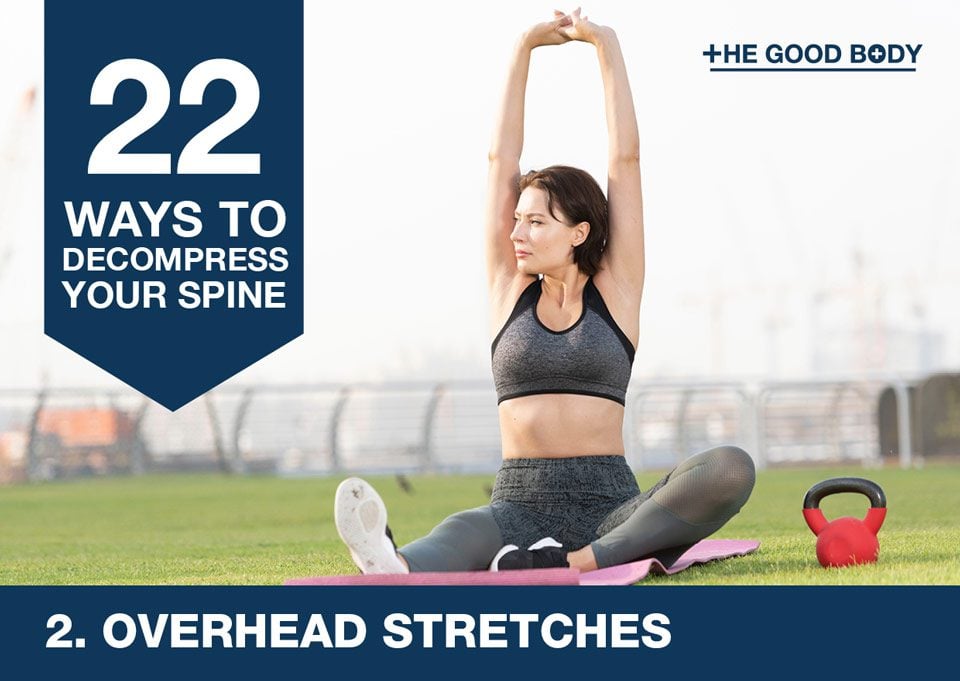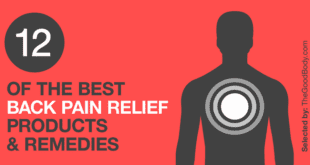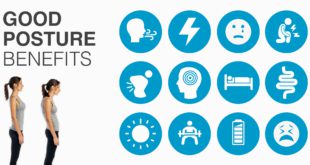An eye-watering 80% of Americans will experience back pain at some stage in life, making it one of the world’s biggest health problems.
Whether you’re pain-free or not, understanding the different ways to practice spinal decompression can be a game-changer for your overall physical and mental health.
Quick Answer
- Lifestyle Changes: Improve your posture, breathing exercises, meditation, quit smoking, change your diet, stay hydrated, sleep more.
- Exercises: Hanging, overhead stretches, stretches with a ball, pelvic tilts, yoga, water-based exercise.
- See a Professional: Nonsurgical decompression therapy, massage, inversion therapy, visit a chiropractor, try acupuncture.
- Last Resort: Spinal decompression surgery.
On this page
- Ways to Decompress Your Spine: At Home and Professional Solutions
- 1. Hanging
- 2. Overhead Stretches
- 3. Stretch With a Ball
- 4. Pelvic Tilts
- 5. Use a Foam Roller
- 6. Nonsurgical Decompression Therapy
- 7. Improve Your Posture
- 8. Focus on Your Breathing
- 9. Practice Meditation
- 10. Try Yoga
- 11. Massage Therapy
- 12. Quit Smoking
- 13. Exercise in Water
- 14. Consider Your Diet
- 15. Lose Weight
- 16. Stay Hydrated
- 17. Sleep
- 18. Stop Looking Down at Your Phone
- 19. Try Inversion Therapy
- 20. Visit a Chiropractor
- 21. Acupuncture
- 22. Spinal Decompression Surgery
- Struggling with back pain? We’re here to help!
Ways to Decompress Your Spine: At Home and Professional Solutions
1. Hanging
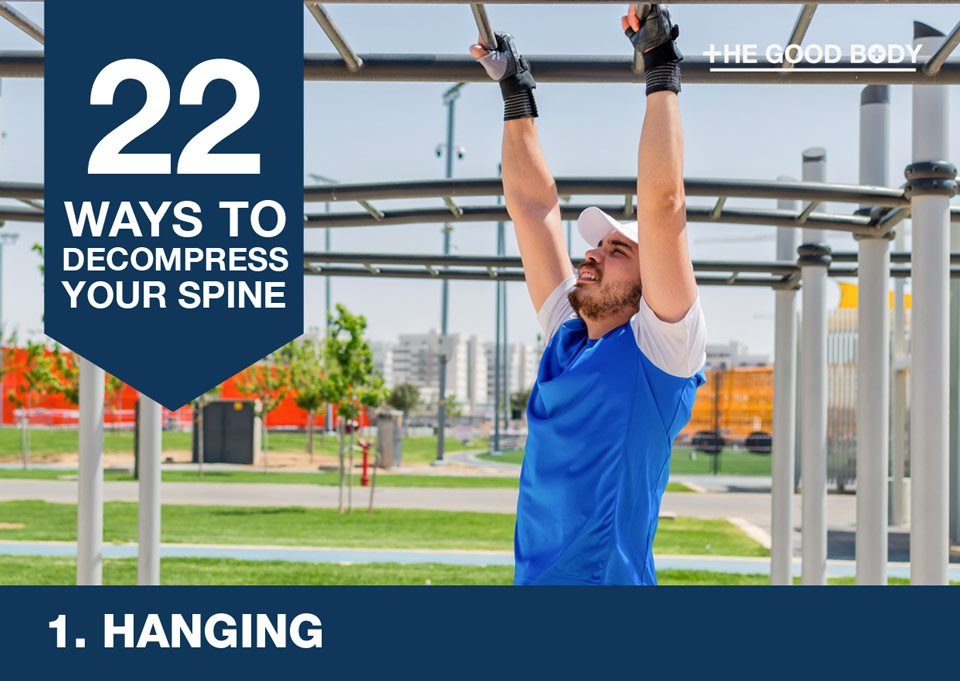
BJ Gaddour, metabolic training expert and fitness influencer, in his book ‘Your Body is Your Barbell’, recommends hanging from a bar daily.
He explains that hanging in a vertical, upright position enables much-needed spinal decompression that lubricates, hydrates and nourishes the intervertebral discs in your spine.
You can pretty much hang off anything stable that can hold your whole body up and allows you to grip with your hands.
The technique also helps you to improve your grip and forearm strength, so it’s much more than a stretch, as the body is simultaneously lengthened and strengthened.
Gaddour explains the best way to maximize your “hangs” is to focus on pulling your ribs and shoulders down, crunching your abs, clenching your glutes and breathing through your belly.
To take it up a gear, you can create a twisting motion with your legs to enhance the stretch through the hips and lower back.
Watch this short video below where BJ Gaddour demonstrates the best way to do a hanging twist:

…compressing your spine is like crumpling damp clothes into a ball—it makes a mess, and throws proper alignment all out of whack.
Worrying, right?
A very simple exercise, to decompress your spine at home, that doesn’t require any equipment is the overhead stretch.
There are just three simple steps to follow:
- Raise your arms overhead
- Straighten your elbows
- Reach your fingers towards the ceiling and hold for 30 seconds
You can repeat this three or more times for ultimate impact.
Still a bit unsure if you’re doing it the correct way?
The Veterans Health Administration have produced a short video to demonstrate the exercise:

3. Stretch With a Ball
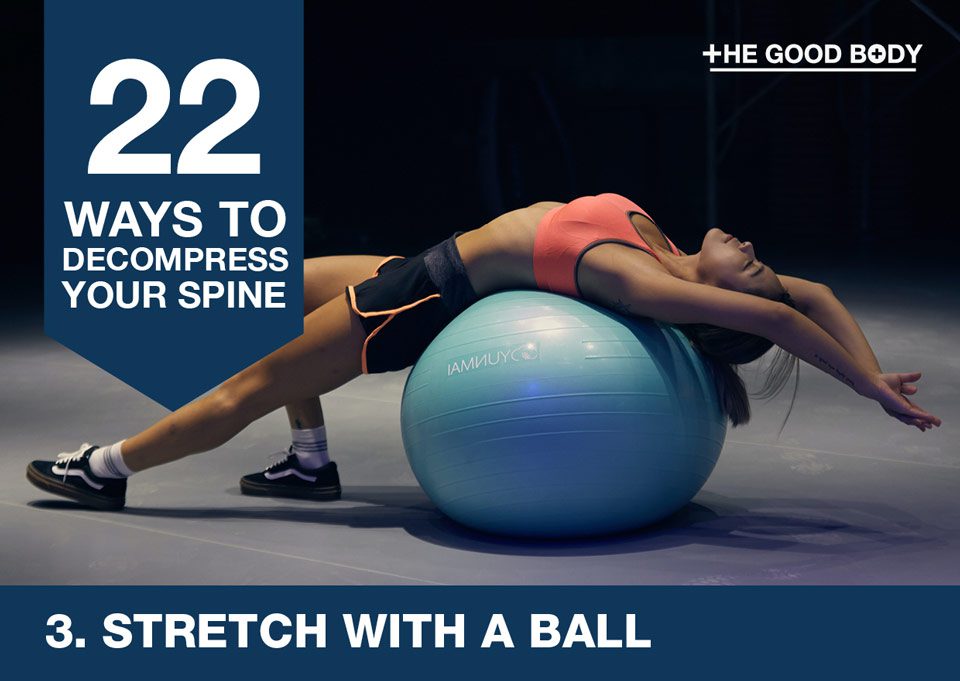
An exercise ball is probably one of the most underrated ways to stretch your low back.
It’s an important piece of equipment as it can also be used to strengthen the core, improve stability, tone arms and help repair all the damage done by sitting down at a desk all day.
Danielle Weis, DPT, a physical therapist and orthopedic clinical specialist at Spring Forward Physical Therapy explains how a stretch with a ball can help:
Longterm—as little as 3 to 6 months—prolonged posturing and inflexibility causes the muscles around the spine to get tight and the spine itself becomes compressed and stiff between each segment.
As we age, compression can worsen and disc health can become compromised, setting us up for future injury.
So what can you do? Prioritize the low back now for the future. Weis strongly believes that exercise balls are a great way to focus on joint mobility and muscle flexibility.
The best thing about an exercise ball is that you’re in charge of adapting how deep or light your stretch is, and air-filled balls are way more comfortable than other harder surfaces so you can endure it for longer.
4. Pelvic Tilts
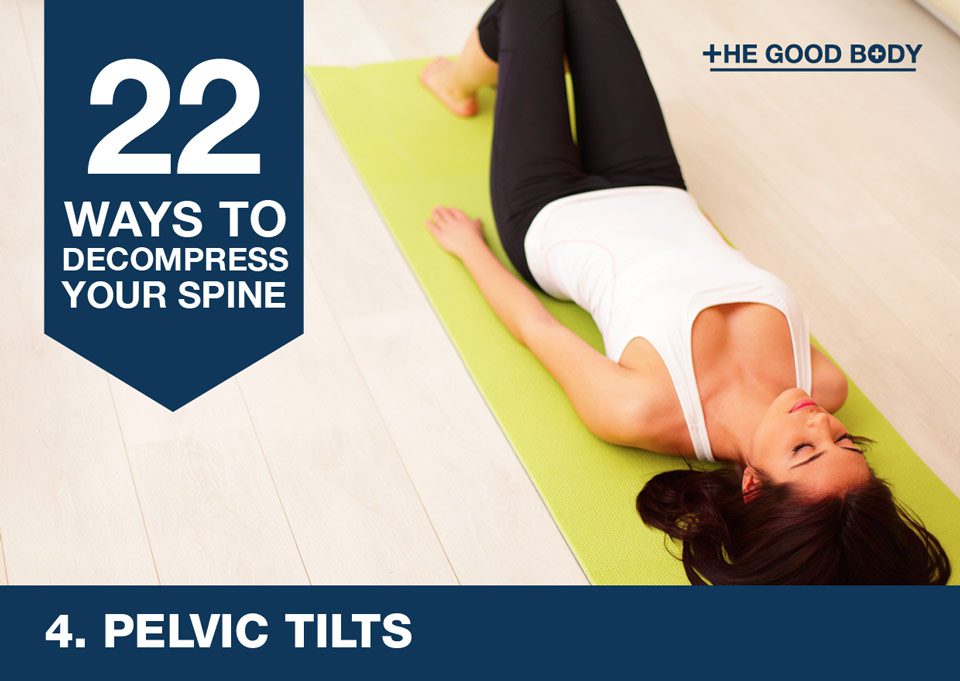
An effective way to decompress the lower back is by incorporating pelvic tilts into exercise routines.
It’s pretty straightforward to do but it packs a powerful punch by strengthening and stretching muscles of the core.
When our core is strong, it provides lots of support for the body, preventing postural imbalances and instability which can result in pain, or worse, injury!
For any pregnant women amongst our readership, you’ll be pleased to learn that research has shown it’s an effective way to relieve low back pain for you too.
However, depending on what stage of pregnancy you’re in, you’re going to have to adapt the exercise so we recommend you speak to your doctor first.
Dr. Brooks, at DSM Spine + Sport, demonstrates a pelvic tilt exercise for low back pain to build lumbar spine stability:

5. Use a Foam Roller
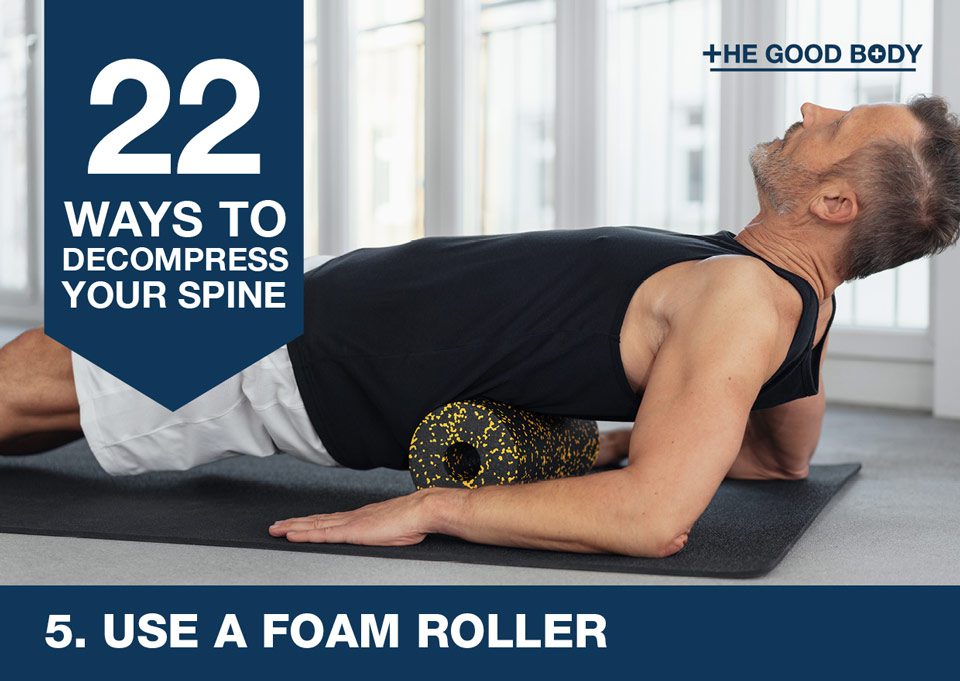
The foam roller is something of a ‘frenemy’.
It’s your ideal self-administering deep tissue massage that releases muscle knots and relieves inflammation, but you can sometimes feel sore while pressure is being applied if you’re in pain to begin with.
Remember though, you’re in control of the pressure and foam rollers do wonders for spinal decompression.
Watch these straightforward exercises you can do at home with your foam roller, demonstrated by Dr Rowe from the SpineCare Decompression and Chiropractic Center.
Regular use can expand your range of motion, increase flexibility, as well as boost your circulation.
According to the Journal of Strength and Conditioning Research, 30 minutes of foam rolling leads to increased blood flow.
6. Nonsurgical Decompression Therapy
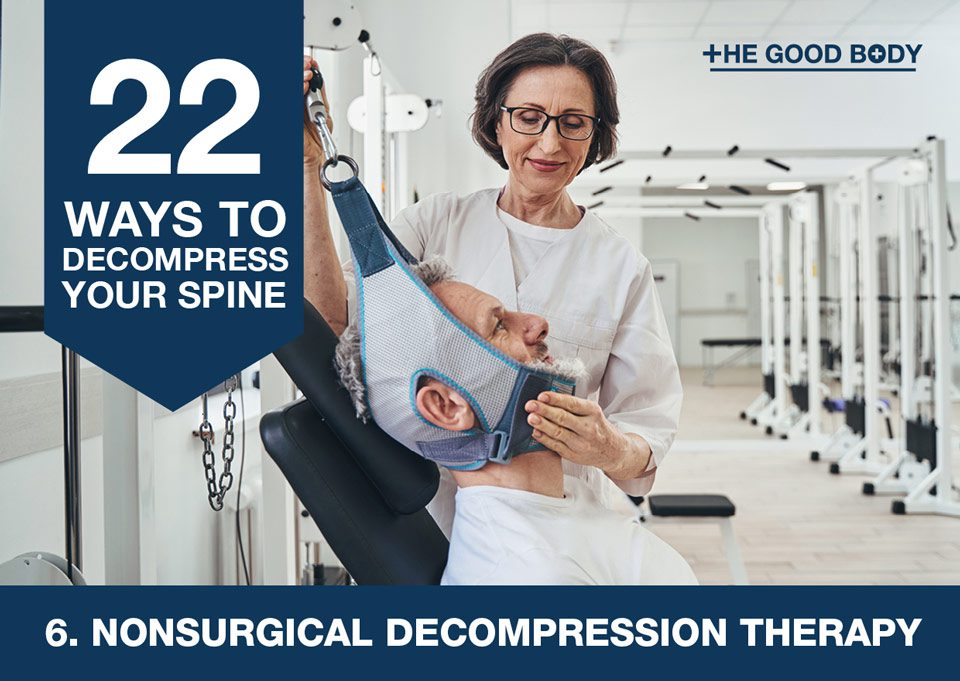
There’s nothing worse than neck pain, it’s an agonizing feeling, but neck/cervical traction may be a good treatment option for you to consider.
This technique pulls your head away from the neck to create expansion and enable decompression. Lightly stretching the neck reduces pressure on the spine by separating the vertebrae.
Cervical traction is normally used as part of physical therapy treatment or you can do it yourself at home with a special device but some may require a prescription.
You should speak to a physical therapist or medical professional, in the first instance to decide the best course of action, and if you do opt to use a cervical traction device at home, they can show you how to use it properly.
A meta-analysis has revealed it’s highly effective, with neck pain significantly reduced after a session, as well as pain scores substantially lowered in follow-ups.
As well as cervical traction, there’s also spinal traction that is used to treat pinched nerves, herniated discs, sciatica, degenerative disc disease and lots of other back conditions. There are two types of spinal traction:
Manual spinal traction — a physical therapist will apply manual force to joints and muscles so gaps between the vertebrae widen.
Mechanical spinal traction — you will lay on a table that has special tools and a physical therapist will use these to relieve pressure.
Although there are no reported long-term side effects, you may experience muscle spasms and have some pain in the treated areas.
It’s essential to speak to your physician so they can review your medical history and recommend the best treatment for you.
7. Improve Your Posture
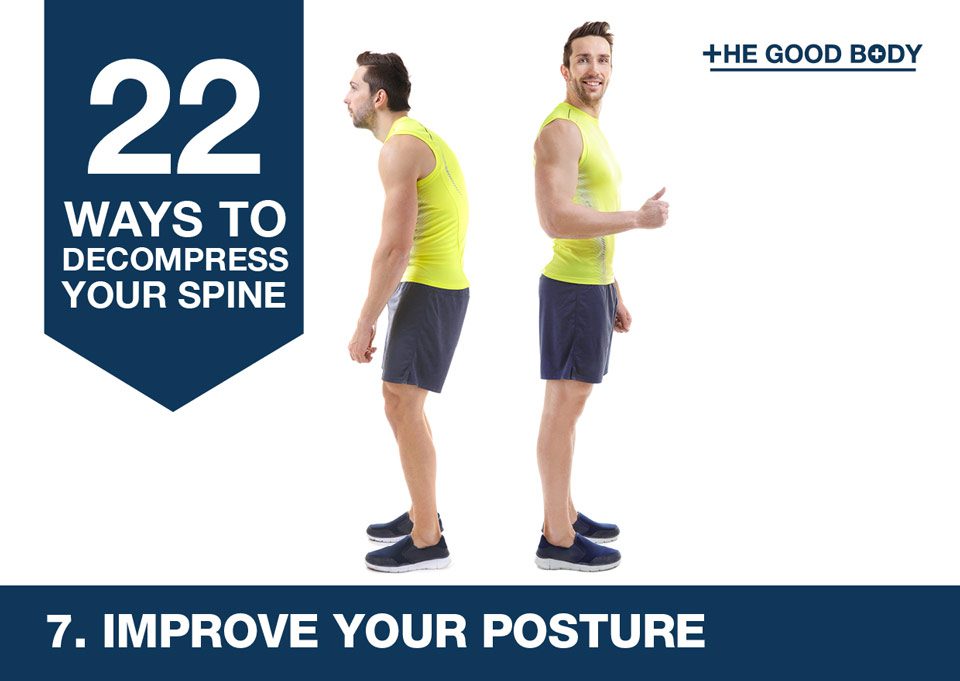
Many of us are guilty of spending our days sitting at a desk and then evenings snuggled up on the couch – this means we’re not enjoying the benefits of good posture!
The ideal position for us is standing straight up or laying down as we’re applying the least pressure on the discs between our vertebrae.
If you’re not standing already, you’re definitely going to want to stand up for this bit of news from the Spine Institute of North America:
When we sit and our backs consequently curve, we’re adding close to 50% pressure on these discs compared to standing.
If we then carry a bit of extra weight, that pressure can increase to nearly 300% with poor posture!
So what is good posture?
Cleveland Clinic explains it involves training the body to stand, walk, sit and lie so we place the least amount of strain on muscles and ligaments while either moving or sitting still.
8. Focus on Your Breathing

Intertwined with posture, and something we do all day that has the power to reduce back pain, is breathing.
The muscles you use to breathe are connected to the five vertebrae between your rib cage and pelvis, so carefully controlled breathing will ease tension in these muscles and help to fix any spinal misalignment.
There’s a stack of evidence that shows healthy breathing habits can reduce back pain or even eliminate it from your life completely.
The Journal of Sports Rehabilitation revealed that breathing programs involving 2-3 sessions per week, with durations ranging from 4-8 weeks, helped to improve low back pain.
9. Practice Meditation
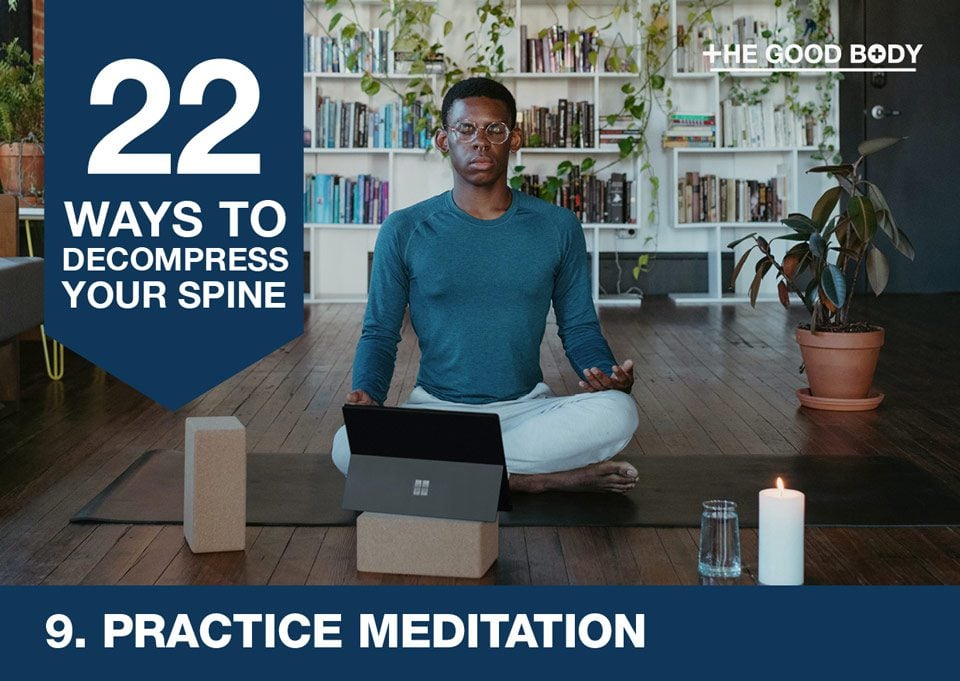
Breathing is a crucial part of meditation, and mindful meditation has been proven by studies to fight chronic back pain.
A randomized clinical trial, involving 342 adults with chronic low back pain, split participants into three groups.
One continued with their usual care, another took part in MBSR (training in mindfulness meditation and yoga) and the third group underwent CBT (cognitive behavioral training).
They practiced across eight weeks, with 2 hour sessions per week. The MBSR and CBT groups witnessed a greater improvement in their back pain.
Whether you’re currently in pain or not, there are many benefits of meditation that you need to know.
10. Try Yoga
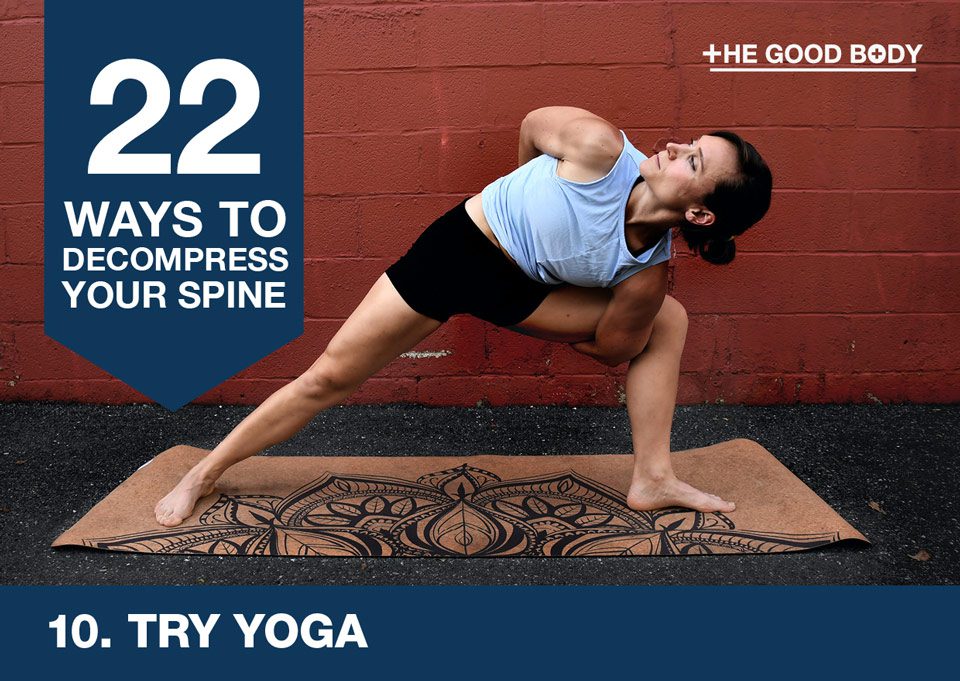
Yoga is the perfect way to alleviate back pain and another form of nonsurgical spinal decompression.
That’s because the movements act as spinal decompression exercises, allowing the spine to extend and rotate.
Yoga poses for back pain include the child, cat and cow pose.
Child pose is an excellent way to strengthen your spine, while the cat and cow pose open up the spine and can provide powerful pain relief.
Why not take it one step further and try aerial yoga?
Just as it sounds, you’re practicing yoga in the air using a suspended swing, hammock or fabric.
As with all yoga it takes time to finesse the poses, but when you do aerial yoga has many health advantages.
11. Massage Therapy
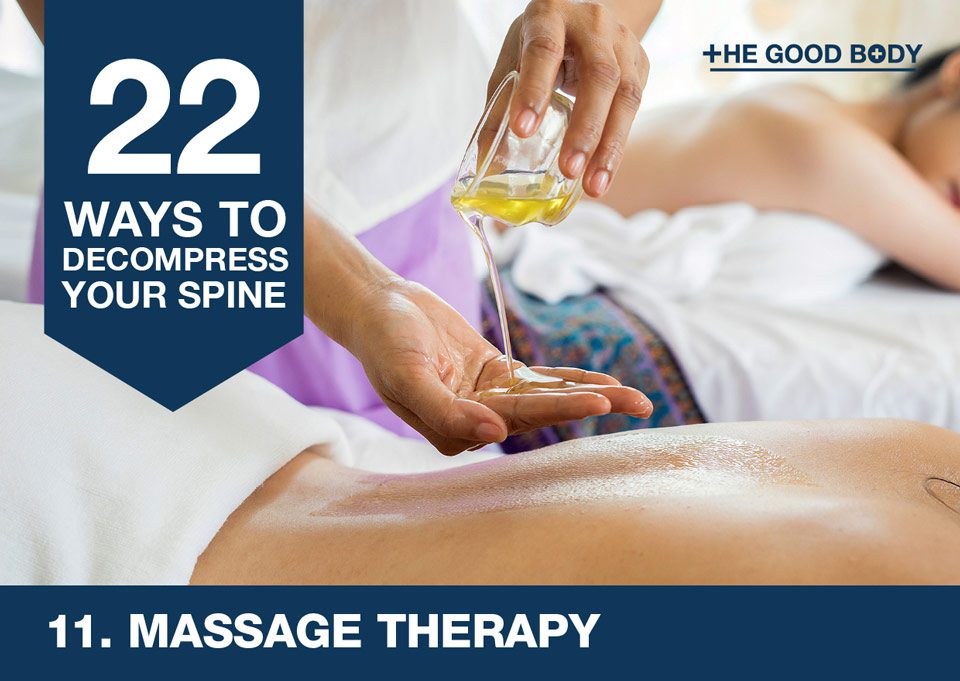
The trials and tribulations of life can take a toll on our bodies and leave muscles feeling tight.
Massage has many benefits, manipulating soft tissues and muscles in the body, making us feel relaxed, and improving our overall wellbeing and physical health.
If you’re experiencing lower back pain, according to Spine Health, most muscle spasms only require four massages over approximately six weeks.
However, if you have severe pain, speak to a medical professional before trying this form of therapy.
Wondering where to begin as there are lots of different types of massage for you to choose from?
All the science points to the Thai massage when it comes to spinal decompression treatment.
It’s an effective way to reduce back pain, relieve joint pain and increase flexibility and range of motion.
Unlike Western massages, you lay fully clothed on the ground while a practitioner uses a mix of techniques to ease tension and get the blood circulation going.
Researchers in Thailand studied the effects of Thai massage on 120 people with non-specific low back pain.
Half of them were treated with Thai massage, and the other half with what is referred to as conservative management techniques (joint mobilization, hot packs and manual stretching).
Treated bi-weekly for 4 weeks, both groups experienced significant pain relief.
There are also other studies that reveal that Thai massage cuts down back pain linked to trigger points in the upper back.
12. Quit Smoking
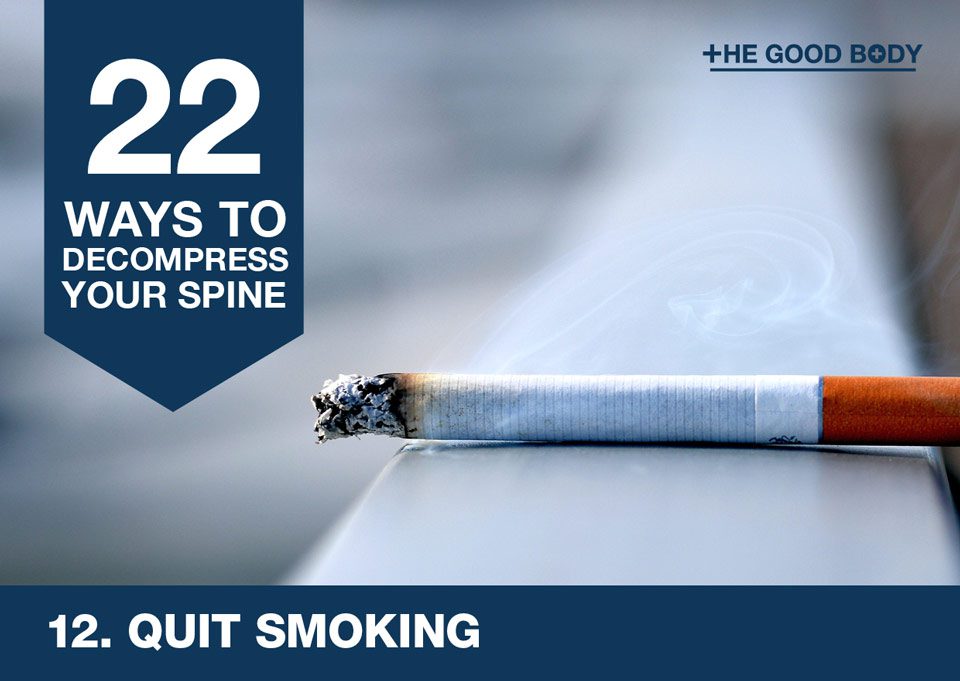
The main reason to quit smoking has to be the fact it kills 440,000 people annually as reported by the CDC.
But what you probably didn’t know is that, according to Health Central, people who smoke are at greater risk of back pain.
Smoking affects blood circulation which plays a fundamental role in keeping you healthy.
Not only does nicotine found in cigarettes have a negative effect on the cells in the spinal discs, but the substances within tobacco reduce blood flow to the spine, and can accelerate degeneration.
And if that’s not bad enough, it inhibits bone healing after spinal surgery.
13. Exercise in Water
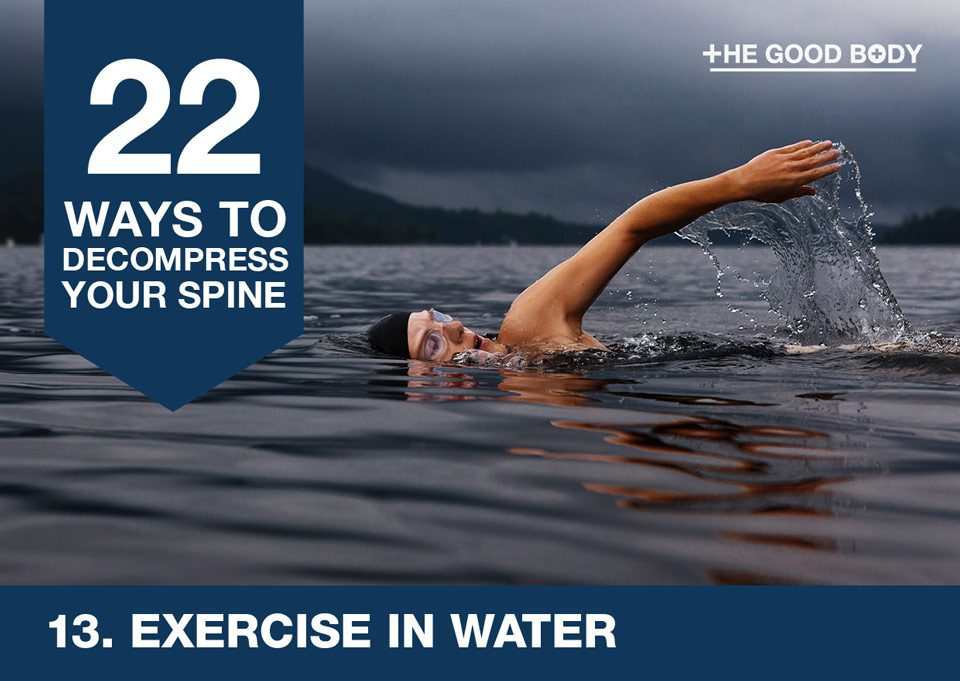
Mixing up your exercise program by shifting from land to water will produce excellent health benefits.
When it’s come to low back and neck pain, it’s been proven to provide relief.
For those suffering with conditions such as osteoarthritis, advanced osteoporosis, muscle strains or tears (who may struggle to exercise on hard ground or even padded surfaces) this form of exercise can be ideal.
But why is exercising in water so effective?
Well, water has three properties and the combination makes it powerful:
Buoyancy – it counteracts gravity and helps to support our weight. This is excellent for the development of better balance and strength.
Viscosity – water provides gentle friction so there’s resistance and this allows for strengthening and conditioning.
Hydrostatic pressure – when you’re exercising in water, you’re improving lung function, as well as boosting muscle blood flow.
14. Consider Your Diet
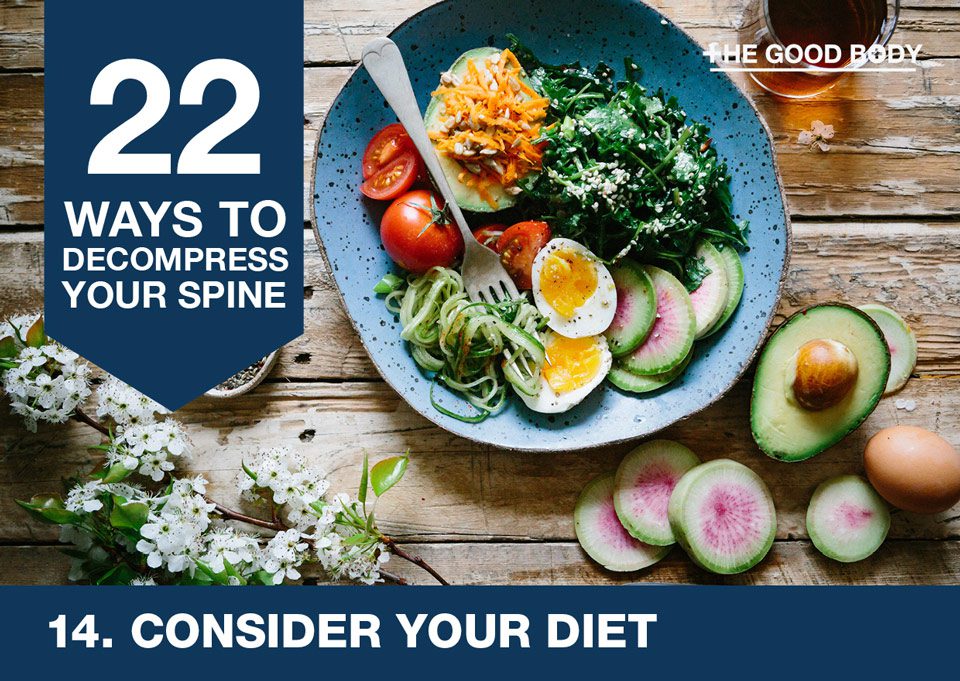
Good back health starts with making the right food choices.
There are eight foods you need to pick up on your next trip to the grocery store:
Plant-based proteins – proteins from plants are better for spine health compared to animal-based proteins that may lead to inflammation. Think chia seeds, lentils and beans.
Vegetables – Not only great for overall health but good for fighting back issues. Kale, broccoli and spinach are anti-inflammatory and contain nutrients to help strengthen your spine.
Salmon – Omega-3 fatty acids are excellent for bone and tissue health.
Dairy products – Calcium is crucial for maintaining and improving bone health, opt for cheese, milk and yoghurt.
Herbs and spices – Fight inflammation and promote spinal health. Think turmeric, cinnamon, rosemary, basil and ginger. You can enjoy these herbs and spices by drinking an anti-inflammatory tea.
Fruits – Berries are wonderful for spinal health and packed with antioxidants and nutrients.
Avocados – Full of healthy fats, as well as fiber and potassium, and help to reduce back pain.
15. Lose Weight
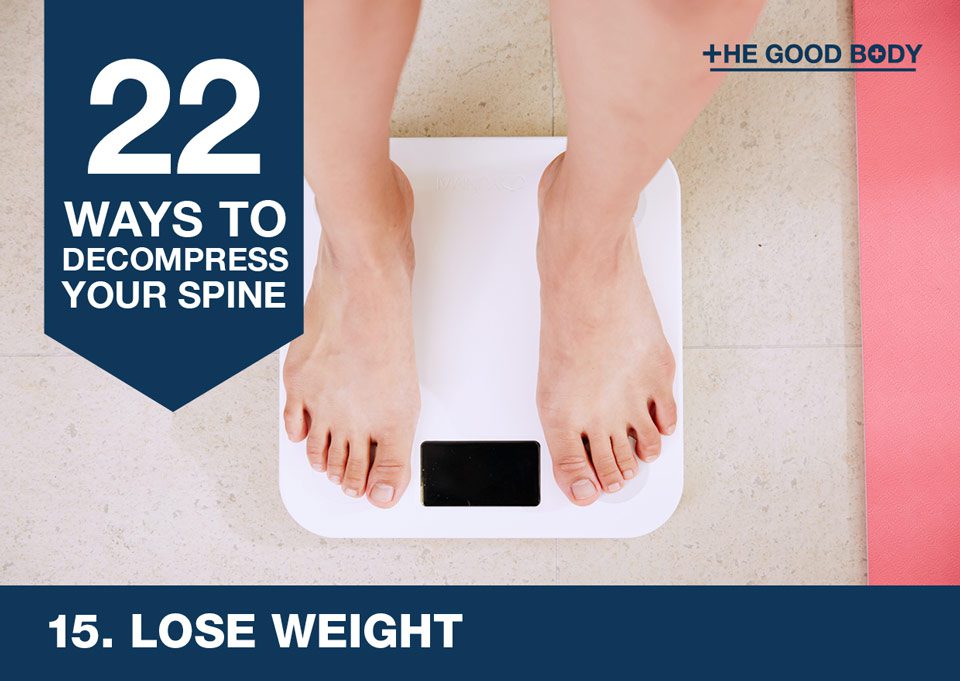
According to experts, you can get rid of partial or complete back pain through weight loss.
Dr. Andre Panagos, physiatrist and director of Spine and Sports Medicine in New York, noted in an article for Verywell Health:
Every single patient in my clinic who loses a significant amount of weight finds their pain to be vastly improved.
If you’re heavier than your ideal weight, muscles have to work that little bit harder so you can complete everyday tasks.
The extra load that the spine has to grapple with may result in the misalignment of the vertebrae and can escalate to painful joint strain.
We need to be careful here because although medical research indicates there’s a strong relationship between back pain and obesity, there isn’t yet the evidence that obesity is a cause of spine issues.
However, there is a compelling study that highlights a link between high-intensity back pain and/or disability with increased obesity in a large sample of men.
16. Stay Hydrated
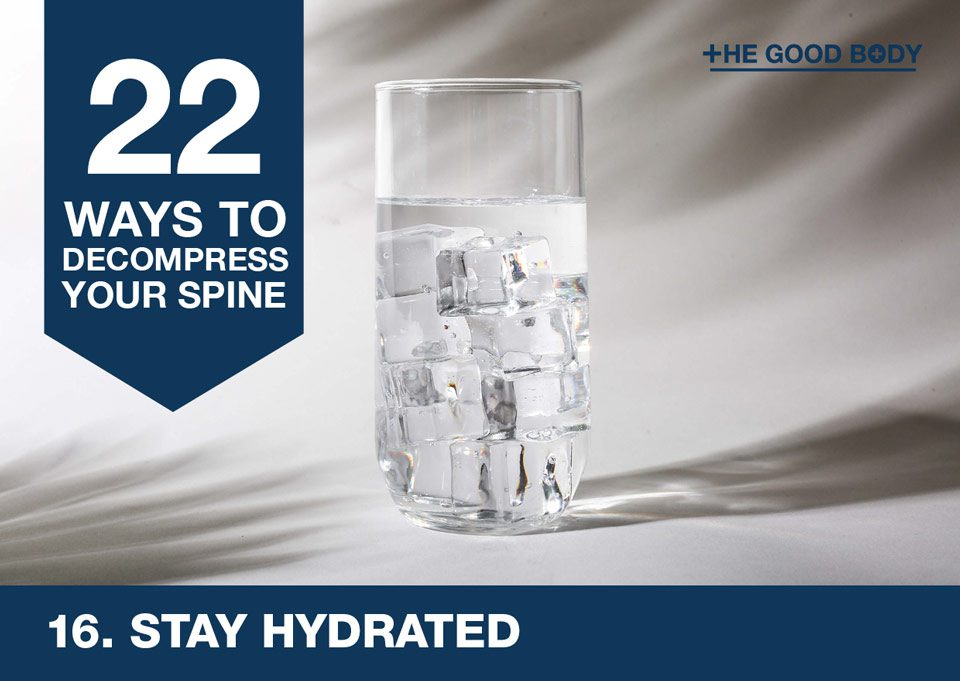
The Spine Institute of North America states that hydration is crucial for the spine because our back holds a surprising amount of water.
Consequently dehydration negatively impacts motion, health and wellbeing. To fully understand the science, we have to think about how the spine is constructed:
The spine is a column consisting of discs, vertebrae and cartilage and the main purpose is to encase the spinal cord.
Discs take the brunt of our daily movement to stop the vertebrate grinding together, preventing harmful shock and allowing us to be flexible.
The discs are made up of water so if there’s not enough water in the discs then it can’t cushion the bone properly and this can lead to painful spinal problems.
As you get older, it’s especially important to drink lots of water because as you age, the discs don’t rehydrate as easily.
Remember “motion is lotion”; a sedentary lifestyle can make it more difficult to rehydrate the discs.
17. Sleep
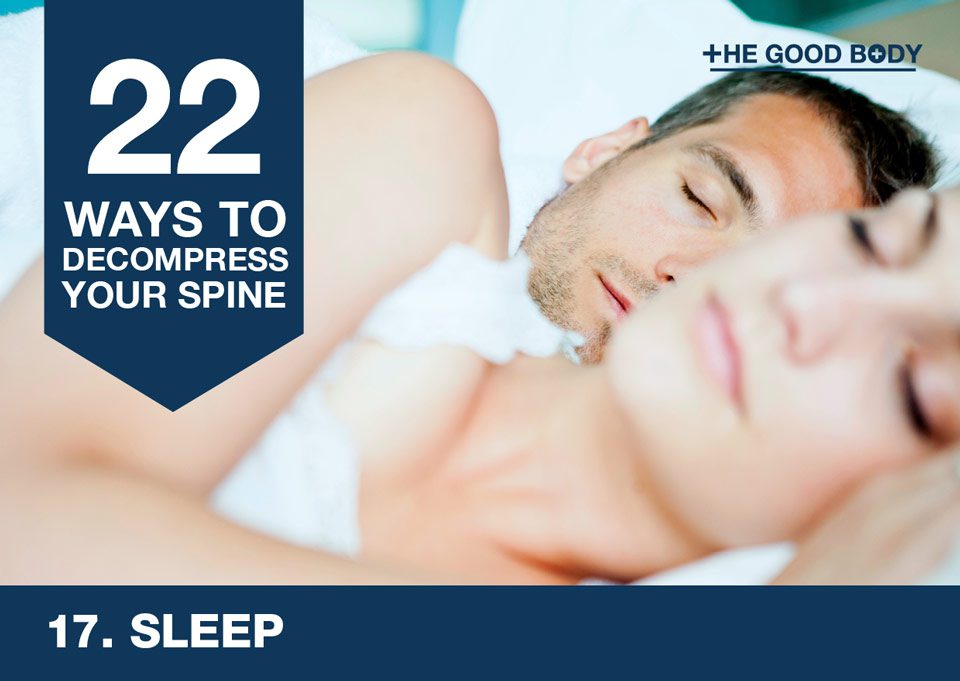
The best way to decompress your spine in bed is to have a good mattress, pillow and to consider the position you sleep in.
Chiropractors recommend a medium-firm mattress because sleeping on a hard surface will lengthen your spine.
As mentioned by Spine Health, your choice of pillow is more important than you think when it comes to easing or avoiding back or neck pain.
Don’t forget, being in pain will have a detrimental effect on your shut-eye and you definitely don’t want to be joining the 35% of Americans that don’t get the recommended 7 hours sleep each night.
When it comes to choosing a pillow, you have plenty of options:
You may want a special orthopedic one, also called a cervical pillow, that offers extra neck support.
They may seem uncomfortable at first, but they help keep the neck in alignment with the spine and will be better in the long-term.
Buckwheat pillows have been around for centuries, and are natural and hypoallergenic, giving much needed support throughout the night.
Doctors report anecdotal evidence that they are great for those suffering with severe disc degeneration, osteoarthritis and spinal stenosis.
It’s also down to personal preference as you may like memory foam, down or polyester. The best sleeping positions are:
Side sleepers: Lay on your side, flex your hips 30 degrees, bend your knees 30 degrees, flex to 30 degrees and place your chosen pillow under your neck. You could also put a thin pillow between your knees to keep your hips in line.
Back sleepers: Bend your knees slightly, place a pillow beneath them at a 30-degree angle to support your lower back and decompress the spine. Your pillow should support your neck and keep your head in a neutral stance.
18. Stop Looking Down at Your Phone
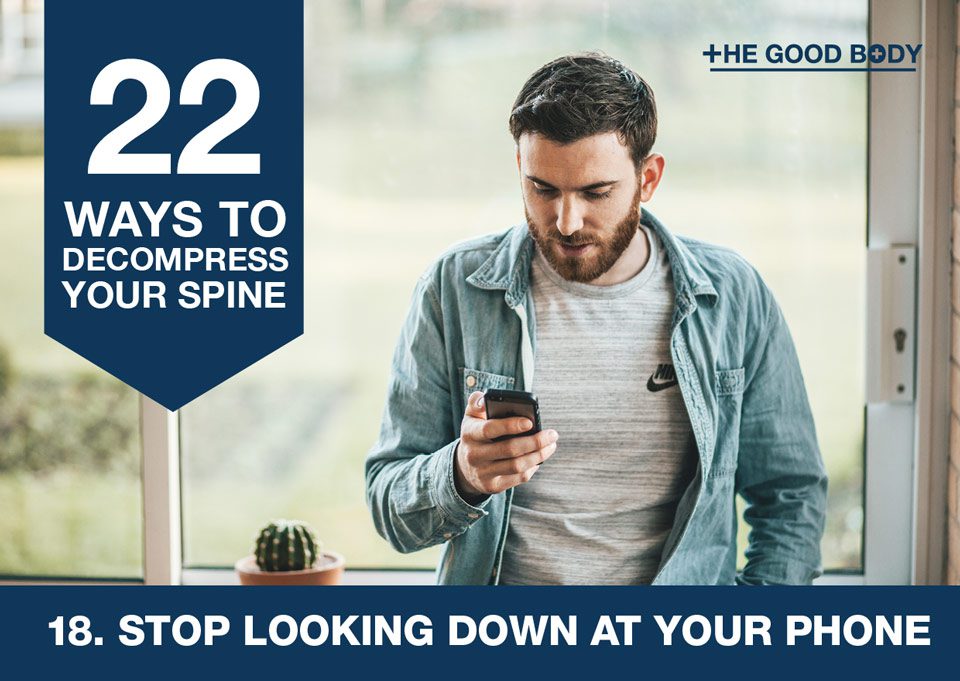
We’re all guilty when it comes to spending too much time on our phones, but you probably didn’t realize how much of a pain in the neck (literally!) it can be.
Statista data indicates that Americans spend an alarming five to six hours on their smartphones each day, and that isn’t even accounting for work-related use.
No wonder many of us experience ‘text neck’, you know that tightness and light pangs of pain you feel in your neck and upper back.
According to Dr Karena Wu, physical therapist and owner of ActiveCare Physical Therapy in New York City and Mumbai:
Looking down promotes a forward head posture. For every inch forward you hold your head, the weight carried down through the spine increases by 10 pounds.
Just think about the massive strain on the back of the neck, as the muscles try to support the head which weighs roughly 8-10 pounds, in the far forward position.
And that’s not the end of it.
Wu explains that ‘text neck’ also:
…creates tightening on the front of the neck and chest which then leads to discomfort or dysfunction into the shoulders and middle of the back.
We know it’s hard to stop looking down at your phone, but there are exercises that can counteract the effects of ‘text neck’ and prevent worse injuries down the line.
Chronic pain influencer, Doctor Jo, guides you through simple neck stretches and posture adjustments in the below video:
19. Try Inversion Therapy
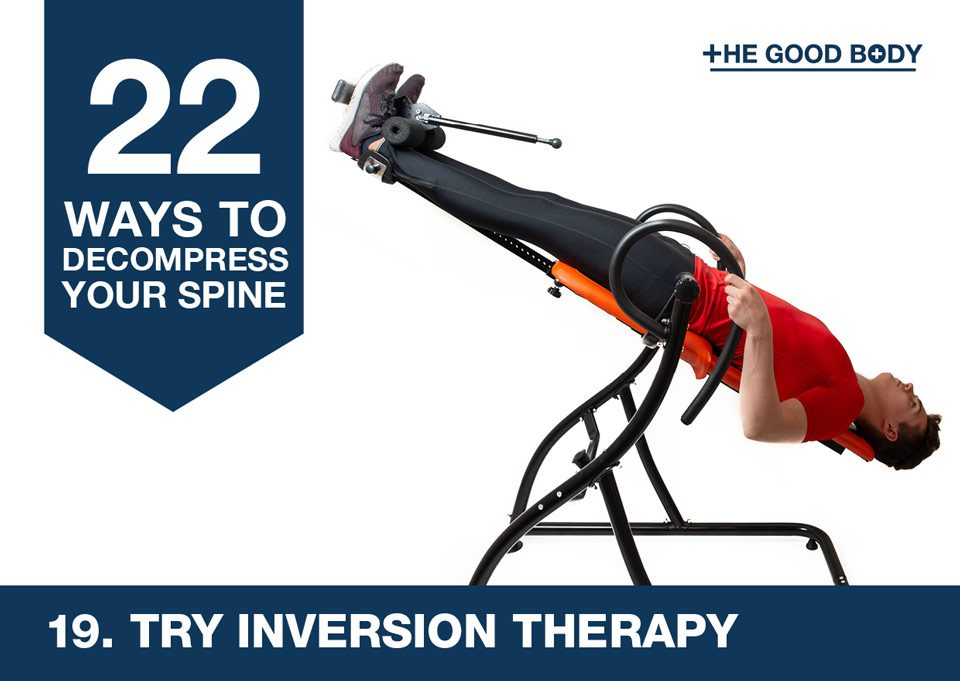
Inversion therapy is another spinal decompression therapy you can do at home.
It involves being suspended upside down on a table to stretch the spine and ease back pain.
Using this spinal decompression device you’re able to shift the body’s gravity, taking pressure off the back and allowing for the space between the vertebrae to increase.
There is lots of research to show that it’s an effective therapy:
One study demonstrated how 47 people with chronic low back pain practiced inversion therapy in three-minute sets at different angles. Through practicing at a 60 degrees angle there was greater pain reduction after eight weeks.
Another study shows the zero-gravity nature of inversion reduces compression and can even prevent disability from back problems, reducing the need for surgery.
However, the Mayo Clinic take an opposing view and state:
Well-designed studies evaluating spinal traction have found the technique ineffective for long-term relief.
They also explain that it’s not safe for everyone so this is something to consider.
20. Visit a Chiropractor
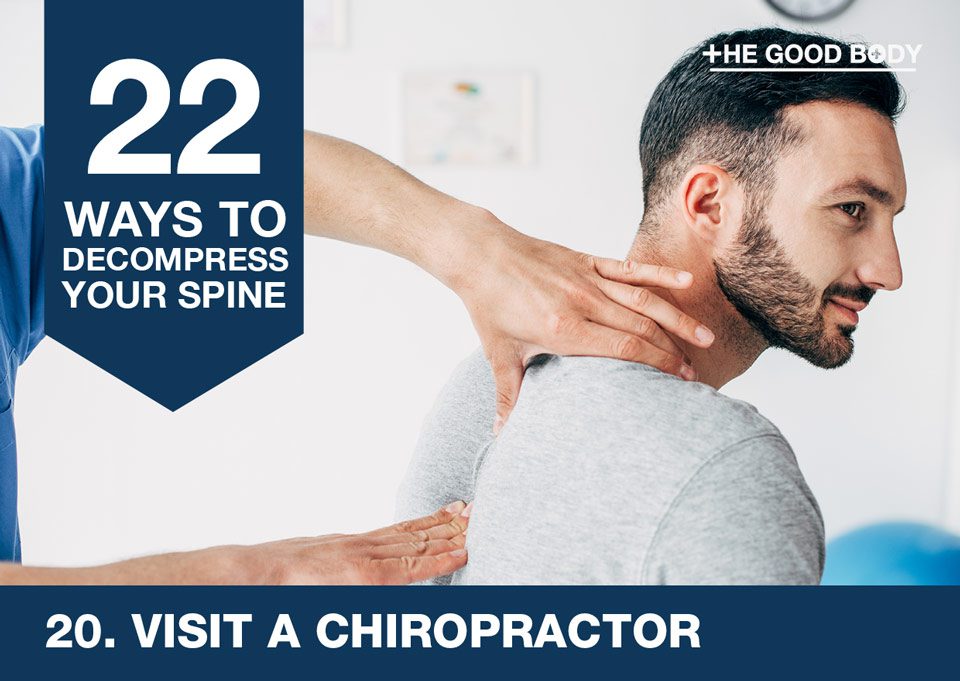
Visiting a chiropractor is extremely popular with chiropractic statistics for 2023 showing that more than 35 million Americans are treated annually.
When you consider the health advantages, it’s no wonder that it’s immensely popular.
Many choose a chiropractor for spinal manipulation if they’re suffering from conditions such as sciatica, neck pain, headaches, as well as low back pain.
A 2018 study involving 750 active U.S army personnel with low back pain discovered that those who received chiropractic care, in addition to normal care, experienced better short-term improvements in low back pain intensity and pain-related disability than those who only received medical care.
It’s relatively safe when performed by a licensed and trained practitioner and the side effects are mild: muscle soreness, stiffness or a temporary increase in pain.
However, according to the National Center for Complementary and Integrative Health, some serious complications, deaths and delays in diagnosis of serious illnesses have been linked to spinal manipulation, for both adults and children, but are very rare.
21. Acupuncture
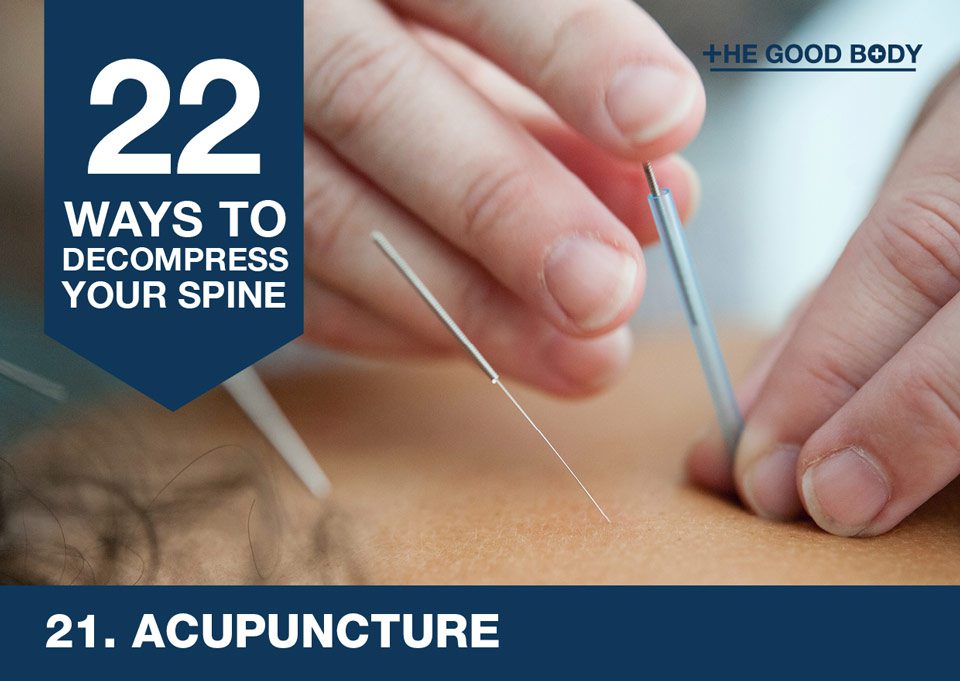
Acupuncture for many isn’t the first line of treatment for neck or back pain but an increasing number of people are turning to it.
The general premise of acupuncture is that an illness or pain is the result of blocked energy, referred to as ‘chi’.
‘Chi’ is important because it gives the body healing energy.
Through treatment blockages are eradicated, using hair-thin metallic needles, and the energy flow goes back to normal.
You’re likely to experience a tingling sensation during treatment because it stimulates the central nervous system – the brain and spinal cord.
One review of 22 acupuncture studies revealed that acupuncture provided short-term relief from chronic back pain.
The American Pain Society and American College of Physicians believe doctors should consider acupuncture as an alternative therapy for patients with chronic low back pain where conventional treatment has failed.
22. Spinal Decompression Surgery
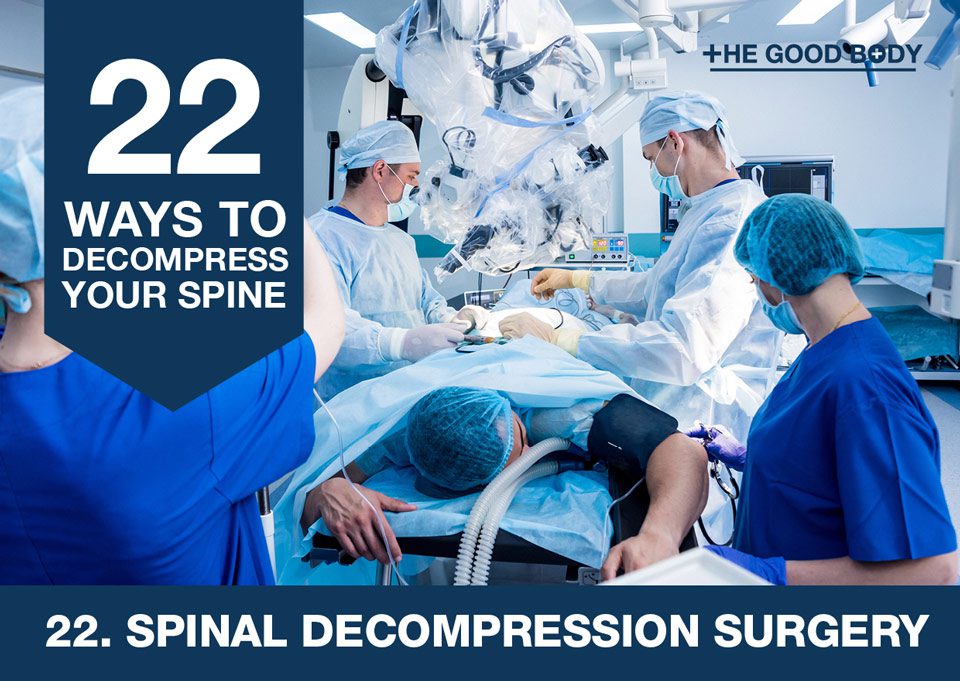
After you’ve exhausted all other options, you may want to consider, or be recommended, spinal decompression surgery.
The UK healthcare system, the National Health Service (NHS), believes that it can be effective for people with severe pain caused by compressed nerves.
For example, people who find walking a struggle prior to surgery are often able to walk for longer and with greater ease.
A longitudinal study at Charing Cross Hospital in the UK, focused on the outcome of spinal decompression surgery fives years on. It unearthed that the early benefits in the period after the operation, may reduce over time.
(Just to note – these findings should be caveated with the fact that they only represent 66% of participants involved in the research because not everyone submitted data.)
There are common risks for this type of surgery such as: infection, blood clots, bleeding, allergic reaction to anesthesia and nerve or tissue damage.
Some believe that there is the risk that it may not improve back pain and that it’s hard work out who will benefit most.
Struggling with back pain? We’re here to help!
We’ve tested many back pain tools here at The Good Body to create our roundup of the best back massagers for 2023.
The list is a mix of different styles, including a seriously powerful device for under $30…
